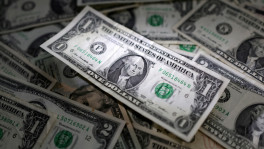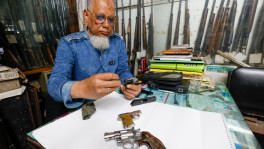The politics of Black oppression explained in 5 Netflix documentaries
As protests continue flaring, Netflix has recently been suggesting documentaries about systematic racism and black oppression

The killing of George Floyd at the hands of an armed policeman called David Chauvin sparked protests across the US and around the world over racial injustice. Protesters have taken to the streets to voice their outrage at long-standing issues like police brutality, systemic racism and oppression.
For years, movies and TV series have been useful outlets for learning about these racial prejudices. As the protests continue flaring, here are five Netflix shows that highlight and help educate people of all ages about the US's race problem and black oppression.
1. Explained: The Racial Wealth Gap
Since the end of the Civil War, the US has slowly worked towards eradicating racial barriers and heal the wounds left by years of slavery. Progress has been made, the Jim Crow laws have been outlawed, the Civil Rights Act has been passed, and the first black president of the US was elected. But the past prejudices have continued to breed present sufferings.
Owning a home had suddenly become harder for those within black communities because the areas were 'redlined' as high-risk areas. And the reality check is that this difference in median household wealth is still growing to this day. A study by the Centre for American Progress reports that the median wealth for black families is $17,600 compared with white families' median wealth of an astounding $171,000.
The racial wealth gap is massive, and it's only getting bigger. But why?The 16-minute episode of the Netflix docuseries helps understand the concept of white privilege and looks at how slavery, housing discrimination and centuries of inequality have compounded to create a racial wealth gap, focusing on how the housing discrimination has continued to impact African Americans and their economic success.
2. Time: The Kalief Browder Story

A 16-year-old African American man called Kalief Browder was arrested in the spring of 2010 from Bronx of New York for a robbery he insisted he had not committed. Browder went on to spend more than a thousand days in jail at Rikers Island, awaiting a trial that never happened. From 2010 to 2013, he spent two years out of the three in solitary confinement, where he attempted to end his life several times.
He was finally released from prison on May 29, 2013. But on June 6, 2015, Browder hanged himself from an air conditioning unit outside his bedroom window at his mother's home. His body was discovered by his mother.
Three things contributed to Browder's tragic story: corrupt correctional officers, three unnecessary years on Rikers Island, and a criminally delayed trial. This six-part Netflix docuseries sheds light on the insane reality of Browder's death at the hands of the corrupt US justice system.
3. When They See Us

The sensitively wrought Netflix series is about what happened to five teenagers of color after they were arrested and charged with raping and assaulting a Caucasian female jogger in Central Park of New York in 1989. When They See Us showcases how the NYPD exerted pressure on the teenagers to confess and talked to them without parents or counsel present while struggling with evidence to convict the five teenagers of the allegations brought against them.
While the NYPD wasted time harassing and terrorizing the five minors, the actual criminal walked undisturbed through Central Park wearing a shirt drenched in his victim's blood.
The four-part true crime miniseries portrays how each of the accused were dealt with individually by juries when they were coerced into giving false confessions and forced to do time for a crime they did not commit. The later lives of the five accused, detailing marriages, work, social justice activism, and other activities, are summarized in the series.
4. 13th
One out of four African-American males will serve prison time at one point or another in their lives. This is the alarming and infuriating statistic the documentary 13th starts with. Named after the Thirteenth Amendment to the US Constitution, 13th will shake you up, but it will also challenge the viewer's ideas about the intersection of race, justice and mass incarceration in the US while never allowing it to cloud the clarity of her message.
13th focused on the fact that the US's prisons are disproportionately filled with African-Americans, compared to the number of inmates of other races. The document also outlines lynching, Jim Crow laws, Nixon's presidential campaign, Reagan's War on Drugs policies, Bill Clinton's Three Strikes and mandatory sentencing laws and analyses the criminalisation of African-Americans and the US prison boom.
13th covers a lot of ground as it works its way to the current days of Black Lives Matter and the terrifying videos of the endless list of African-Americans being shot by police or folks who supposedly stood their ground. The documentary is as time sensitive as the latest Black Lives Matter movement and the approaching 2020 presidential election.
5. Who Killed Malcolm X?

The documentary follows the work of Abdur-Rahman Muhammad, a historian and tour guide in Washington, DC, who has been investigating the assassination of Malcolm X for over 30 years. 55 years after a bloody afternoon in February 1965, the Manhattan district attorney's office is reviewing whether to reinvestigate the murder of Malcolm X.
The six-part documentary uncovers new evidence about the assassination, and a conspiracy, too, while delving into the beliefs and mysterious death of Malcolm X. The show posits that two of the men convicted could not have been at the scene on the same day. Instead, it points the finger at four members of a Nation of Islam mosque in Newark of New Jersey, depicting their involvement as an open secret in the city.
The documentary looks at the role played by the puppet masters - from the FBI to the nonchalant NYPD, police brutality was a significant problem in the 1960s and recent footage and images show this is still true today.


 Keep updated, follow The Business Standard's Google news channel
Keep updated, follow The Business Standard's Google news channel
















